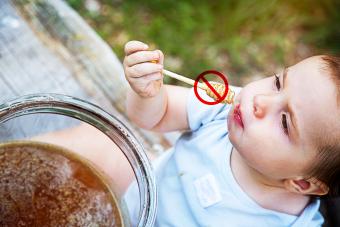
Baby eyesight develops rapidly after birth. There are several stages that an infant's vision goes through in the months following birth, and moms and dads can have fun with games that stimulate baby's sight at the same time.
Stages of Baby Eyesight
Immediately after birth, an infant can see from eight to fifteen inches in front of her face, but things are blurry for babies at this stage. Very young babies typically show a strong interest in the human face, so mom and dad can help spend plenty of time looking at and talking to their baby to stimulate that interest.
The First Month
During the first month after birth, a baby's eyes may cross because limitations in the nervous system mean his ability to focus is not well-developed. While babies can see colors at birth, they cannot distinguish the colors well, so during the first month they pay attention to high contrasts best. Moving objects also quickly capture the attention of infants at this age.
Mom, dad, and other caregivers can interact with baby by staying about one foot in front of his face; babies quickly learn to distinguish facial features. At this stage, parents can also stimulate baby's sight by passing objects slowly back and forth in front of her face to encourage the ability to focus. Locking eyes with your infant and then slowly moving away will also help with focus, since babies have a special affinity for eyes and faces. Exposing baby to brightly contrasting object (in colors such as black, white, and red) will also spur his interest in visual exploration.
Month Two
By the second month, many infants have learned to make eye contact. She may follow items with her eyes, but the tracking may not be smooth or may be easily interrupted. Babies at this age also show an interest in edges or borders, such as the jawline or hairline, or distinct edges or borders on objects.
Continue to play tracking games with him, moving objects in front of his face and offer plenty of face to face interaction to stimulate baby eyesight development. You my also want to show toys or items with high contrast borders. Avoid overstimulation of bright lights and too many moving objects at one time, since baby's developing sight can be sensitive. Cease the activity or take him to a less visually stimulating area to calm a crying baby if the surroundings seem to be too much.
Month Three
By month three babies can see colors with more clarity. At this stage a baby's focus has improved, and he is able to more smoothly follow or track an object with his eyes. Infants at this stage especially enjoy items like mobiles that have moving parts. You can keep stimulating your infant's vision by showing him brightly color toys, books, and objects of different shapes. Typically by this age an infant's eyes have ceased random wandering or crossing, so it may be helpful to consult a physician if this is still occurring at this stage.
Four to Six Months
By four months, a baby's color vision is typically fully matured, and he can distinguish easily between colors. Baby eyesight during this period is also becoming more adept at perceiving small details, and their distance vision has also improved, allowing them to see objects farther away. Depth perception begins developing at this stage and will continue to improve as baby grows.
Babies at this age are often fascinated by mirrors. Play with baby by holding a small mirror in front of her face, or affix an unbreakable baby mirror to her crib in an easily accessible spot. At this point, infants may also be able to recognize an object by viewing only part of it, so parents can play games in which part of an object is hidden to improve both infant cognitive development and visual skills.
By Eight Months
Distance vision continues to improve, and a baby at eight months of age can typically see and recognize people or objects across a room. According the Encyclopedia of Children's Health, at this point a baby's ability to see detail has improved to 20/30, nearly the level of an adult's normal visual acuity of 20/20.
By Ten to Twelve Months
A big milestone at this stage is that baby's hand-eye coordination has greatly improved, allowing him to view objects and grasp them (and often, to a parent's chagrin, put objects right into his mouth). While some aspects, such as depth perception, will continue to improve, a baby's vision by twelve months is largely mature.
Checking Baby Eyesight
The American Optometrist Association recommends that infants have their first eye exam at the age of six months to assess development and check for the occurrence of any baby eyesight abnormalities. However, if you are concerned about your infant's eyesight at any time, contact your physician. Typically the earlier eye problems are discovered, the more easily they can be treated.
Keep in mind that quality time playing with, feeding, and holding your baby all contributes not only to his developing eyesight, but also to his cognitive skills and his other senses. Even the simplest acts of showing your baby new objects and making frequent eye contact will help stimulate sight development, and encourage the lifelong bond between you and your baby.
.







